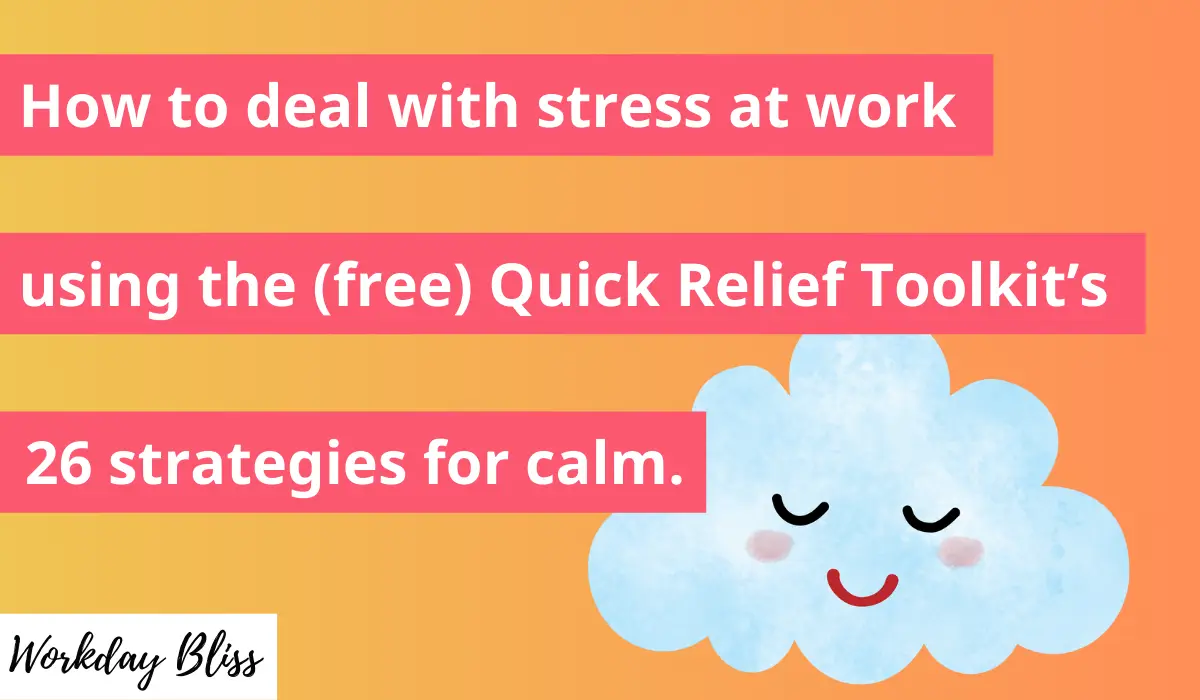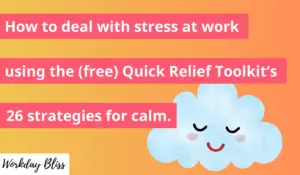
How to deal with stress at work
Using the (free) Quick Relief Toolkit’s 26 strategies for calm
In this post I share a few tips you can use to make the most of the Workday Bliss Quick Relief Toolkit.
“Relief from what?” you might ask. Since it’s a common offender, I’ve chosen to focus this post on how to deal with stress. Usually that’s in moments where you find yourself in the tension between the expectation (yours or someone else’s) and what’s possible. The Quick Relief Toolkit might also be used for other situations though, like feeling uncomfortable, unmotivated, frustrated, etc.
Ok, let’s get into how to deal with stress that arises in your workday. I’ll set the scene:
Your morning is going smoothly, the sun is shining, the birds are chirping outside and a ray of sun through the window is warming your shoulder. You are pleasantly going about your work, getting started on a project with all this fresh energy.
You see an email pop up from your boss. She’s responding to a document you sent last week to get her feedback. You need to get a final draft out by the deadline today.
You don’t want to get off track with what you’re working on this morning. So you say to yourself, “I’m just going to open this email to make sure it has the feedback I need, and then I’ll come back to it later.”
You click that email open and peer at its two-sentence response: “Good morning. Let’s find a time to talk more.”
Okay, that’s not ideal, you’re running out of time. But she’s the boss. You start to feel some stress thinking about the deadline being today. You are also recalling last week, when you carefully composed your email with bullet points for clarity and important questions in bold. You emphasized the deadline in a few places. You sent a reminder to her a few days ago. You tried so hard.
BUT nonetheless, you are still holding together. You remain calm and let all that go. You think, “let’s meet and get it taken care of.” AND THEN: you open her calendar to find a time to get this deadline met today. She is already busy in meetings. All. Day.
AHHHHHHHHHHHHHHHHHhhhhhhhhhh….
On the outside, you’re still playing it cool at the computer. On the inside, your face feels hot, your stomach is in a knot, your heart is pounding. Stress has set in. You made so many efforts to stay ahead of this deadline and now you’re going to have to deal with it at the last minute under pressure. Not to mention your freedom has been impacted and you’re now likely staying late at work tonight.
There you sit, f*ing stressed.
HOLD UP (DJ record scratch sound). Wait a second, what happened to the chirping birds, the ray of sun, the fresh energy to start your day? How did they seemingly go away in an instant, with the click of an email?
This email from your boss is a bummer, but how you’re feeling now is even a way bigger bummer.
Which means you’re not only dealing with the thing that led to the stress, but how to deal with stress itself.
A relatively minor (in the grand scheme of life) thing can get our bodies and minds in stress mode, big time. You’re just knocking out a project, and then all of the sudden you find yourself in the Hunger Games and, Katniss, your bow just broke. But it didn’t. You just got *an email* and your life is probably not at stake. But dang your body is amped about this situation right now.
That’s where the Quick Relief Toolkit comes in.
Now, your day is probably going to play out in one of these ways:
A: Your stress dissipates eventually when a practical solution arises. Maybe your boss can change her schedule around to fit in time with you. Or the deadline can be extended. That would be nice, it could totally happen. And you would be free.
B: You keep feeling stressed because, you find, there is no practical solution. This is going to be a late night, high-pressure, stress mode day.
→ But now presenting…. Option C ⬇️
C: You get relief from stress immediately using the Quick Relief Toolkit. Maybe you find a solution, maybe you don’t. But regardless, what’s that you hear? Oh, that’s the birds chirping! And at least for the moment, you’re feeling at peace going back to your project this morning.
The Quick Relief Toolkit includes 26 strategies for how to deal with stress in moments like these.
*Cue a sigh of relief from your imaginary self who just lived through this scenario.*
Depending on where you are both physically and emotionally, different options will work best. Some of the Quick Relief Toolkit strategies are useable right there at the computer screen. Many are office-friendly in general. And some are a good fit if you work at home or after work. I also marked my personal favorites on the list to show you the ones that work best for me.
You could go straight to the toolkit to grab a strategy. Or, here’s a flow that can help get the maximum benefit.
➡️ How to deal with stress at work using the Quick Relief Toolkit strategies.
1. “Will Return In: 5 minutes.” 🚪
If it’s an option, find somewhere you can be uninterrupted for a few minutes.
That could be closing the door or going out to your car. It could be sitting quietly at your desk in a shared office space while you coworker types away.
If that’s not an option, no problem. There are some strategies that can be done on the fly, like when you’re sitting in a meeting.
You can always try out some strategies before or after your workday, so they are easier to recall in the moment.
2. Stop the internal wrestling match. 🤼
Choose relief.
Decide that for right now, you would prefer to feel relief. Maybe that’s from stress or frustration, or even from mellow discomfort like boredom or tiredness.
If you’re hanging onto the problem and, at the same time, trying to feel some relief using the strategies in the Toolkit, the problem will probably win.
Now, your mind might be fighting you on switching gears to find relief. It could be back there churning on solutions or replaying a difficult moment.
That might happen in the background anyway, but what you do have the power to do is decide that it’s okay to take a momentary break from this feeling or problem.
Being on board with releasing what’s going on in your thoughts, even just for a few minutes, will make a little space for the Toolkit strategies to offer you some relief.
3. Peek at the scary movie scene. Crack open just one eyelid. 🫣
For a moment, allow yourself to look at what you’re feeling and let it be there.
There’s a good chance that when this challenging feeling crept in, your mind began trying to avoid it. Maybe you started to focus harder on the task you’re working on, or maybe you found an entertaining distraction (your phone, a snack) to drown out the feelings.
If you find your mind has brought you elsewhere, bring yourself back just enough to notice the not-so-good feeling you want relief from. You don’t need to, nor is it helpful, to dwell in it. You’re just bringing your mind back toward the moment.
4. Pull out the handy dandy toolbox. 🔧
Try a few strategies in the Toolkit.
The Toolkit is broken into has nine categories of strategies:
- breath
- self-massage & pressure points
- movement
- touch & sensation
- sound
- smell
- taste
- sight
- rest & refuel
Go for a category that feels appealing to you, and start with one strategy.
Focus on really experiencing the strategy. Feel the sensations in your body. When your mind wanders, bring it back to those sensations.
If you have time, pick another option from the Toolkit. Or stay longer with what’s working. Keep it to a couple of minutes per strategy as you explore.
Sometimes you’ll try one, and it won’t help at all. Or it gives you a little relief but the feelings persist. Flow with however much or little each one helps. After you’ve pulled the toolkit out in a few situations, you’ll likely find some go-to options that work the best for you.
Whichever strategy you choose, you can supercharge its powers by opting for a version that connects you with nature’s calming effects. Depending on the strategy and your situation, that might look like: going outside to walk along a tree-lined sidewalk, searching out nature indoors like office plants, viewing nature out the window, or finding videos and sounds of nature.
5. Plan A not working? Here’s plan B. 🏃♀️
If you try a few strategies and are still struggling, use a distraction for now.
Strategies that keep us mentally present in our bodies, like many of those in the Quick Relief Toolkit, have the potential to give us long term benefits. They can help reinforce a new path for how to deal with stress. That way we can find ourselves in a state of calm and ease more often.
There’s also another, sometimes more potent approach: distractions.
The trouble with distractions is they can be short-term fixes. They have us mentally escaping the moment to get relief.
BUT, if none of the other strategies are working fast enough to get back to work, sometimes a distraction can pull you out of it.
TIP: Avoid choosing distractions with consequences that are going to make things harder later. Pass up comfort food, alcohol, drugs, or shopping.
Instead watch a funny cat video, bring to mind a positive memory that comforts you, plan time later to do something that feels good and is good for you, read a page in a novel, watch 5 minutes of a light-hearted tv show. Afterward the only cost was the time you spent finding peace.
To sum it up, this is a flow you can follow to use the Quick Relief Toolkit to change how you deal with stress that comes up with work:
- If it’s an option, find somewhere you can be uninterrupted for a few minutes.
- Choose relief.
- For a moment, allow yourself to look at what you’re feeling and let it be there.
- Try a few strategies in the Toolkit.
- If you try a few strategies and are still struggling, use a distraction for now.
Ready to try it out? Get your free copy of the Quick Relief Toolkit: 26 Strategies for Calm.
Posting Date: September 4, 2024

Meet the Author
Hi, I'm Ciara. I'm the creator of Workday Bliss where I write and teach about ways to bring more balance and productivity into your workday.



